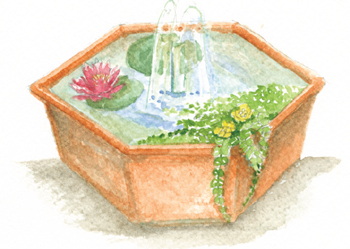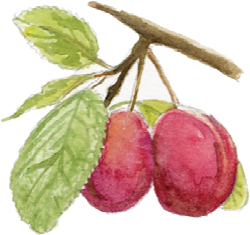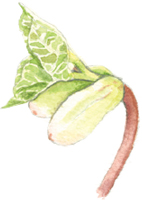

Making a pond
Plants are so generous in nourishing our senses – sight, taste, touch and smell – that I hadn’t realized, until sitting beside a friend’s spacious rooftop pond and its fountain, that sound was the only sense missing from my roof garden. It has the reassuring buzz of bees and the deliciously watery sounds made by birds deciding which of the ‘orchard’ plums to eat; what is missing is the cool trickling and light splashing of water – especially refreshing when heard in the centre of a city.
I had always looked down on artificial ponds, associating them with eternally fishing gnomes and hollow, fibreglass rocks. I had also wrongly assumed that having a pond involved filters, bungs and other underwater equipment. My rooftop friend assured me that this was not so and that a mini-pump fountain is simple to install. It was – in about half an hour.
Before skipping this part of the book, thinking that your balcony is too small, wait. Even the smallest balcony – just deep enough for two feet to stand on – can have a fountain and/or a pond. Windowsill owners can have small fountains or waterfalls. And for those living in flat-chested flats without window ledges who are desperate for the sound of water, there are indoor tabletop fountains.
Wall-mounted, puffed-cheeked, dribbling cherubs, lions and goddesses or incontinent boys do not make particularly attractive waterfalls, though at least the boys make more sense than the others. The simplest and easiest method is to put the pump inside an imitation-terracotta plastic tub. It has to be plastic, a) because of the weight and b) because containers without ready-made drainage holes are hard to find. These drainage holes are marked on the plastic and left for the owner to drill or not drill.
My tub is hexagonal in shape, 16in (40cm) in diameter and 9in (23 cm) deep, so there’s no danger of drowning. Being plastic, a hole was easily drilled in it, about 1in (2.5cm) from the top, to allow the pump flex to pass through.
So far all that is needed is a ‘mini-cascade’ pump, a plastic tub (yours could be smaller than mine) and an RCD (residual current device) to protect against electric shocks – all available from most garden centres.
The fountain has three settings. The lowest and narrowest is ‘Intimate Evening’, the tallest and widest ‘Blackpool Lights’ and the third ‘Upturned Jelly’. With an additional piece of plastic hose there could also be a waterfall.
The surface of my tub-pond was going to be covered with chicken wire to support big pebbles and stones, creating a pseudo-Japanese effect. Then, while looking at the bare face of the water, I wondered about aquatic plants – an aspect of gardening that had always seemed totally alien to earth gardening, and unachievable on a rooftop. However, a few hours later, after reading about ponds, I was walking round an aquatic garden centre – something else that I didn’t know existed.
Now, floating on and growing over the edges of the tub are a pygmy waterlily, which promises to produce pink flowers (it comes with a guarantee); creeping Jenny, which has yellow buttercup-like flowers; cotton grass – untidy wispy heads, which look bedraggled after rain and badly blow-dried when dry; floating beaver with, appropriately, beavershaped, almost furry-looking, boat-like leaves; and parrot’s feather, with its fluffy-duster-ish leaf. The above list makes it sound more like a zoo than a pond. If it were larger, frogbit, water crowfoot, turtlehead, scarlet monkey flower, toad lily, skunk cabbage and zebra rush could also be added. Apart from the above list, also available are sweet flag, brandy bottle, Joe Pye weed, submerged water soldier, fairy moss, yellow floating heart or water fringe, arrowhead, bugle, and many more whose names are as intriguing as the plants.
Alternatively, there are plastic waterlilies, guaranteed ‘to beautify your pond all year round’ and no doubt machine washable.
Aquatic plants are divided into five types: ‘free-floaters’, ‘marginals’, ‘oxygenators’, ‘fixed-floating aquatics’ and ‘waterlilies’. Sounding far more knowledgeable than I am, I can now discuss with other pond owners the merits of free-floaters and marginals versus oxygenators and fixed-floaters, enjoying these five new additions to my vocabulary.
I had not imagined that something that is only 16 x 16 x 9in (40 x 40 x 23cm) filled with water, plants and a fountain could also contain so much pleasure. I visit it several times a day to see what is going on. A lot is (see the June chapter).
The last of the five senses, hearing, is satisfied.
Good Friday potatoes
The Good Friday potatoes should now be breaking through the surface of the compost, their tips green. As they ascend, add more soil, covering stems but not tips.
The orchard
The orchard will now be in full sail with blossom. It is quite difficult for an uninitiated eye to tell the difference between pear, plum and cherry blossom. Now is the time to find out. Insects are visiting the blossom; the lonely self-fertilizer is making the best of a bad job, preparing to perform the equivalent of an immaculate conception.

Tomato plant roots
If tomato plants were sown in the transparent supermarket trays, by now they will have been transplanted into individual pots. It is then, and while in the transparent trays, that their roots can be observed, growing many times as long as their stems, but only a fraction as thick. This underground root world we know so little about is just as interesting. Over, round and through compost obstacles – lumps and bumps – they go in search of minerals, salts and water, fragile but determined.
Remove the older-generation vegetables. Some, such as frizzy endive, become bitter after a time and although they may still look splendid, it is time to remove them. The hanging basket they occupy will be needed for alpine strawberries.
Vegetable bouquets
When removing senior vegetables, don’t just put them straight on to the compost heap. Let them spend time in a wide-mouthed bowl as a bouquet. The frizzy endives’ bright light-green frilly leaves will fill and froth over the bowl.
Compost: to activate or not
To return to the compost heap and the question of whether to add an activator (something which hurries up the process of decomposition) or not. Some people do, some don’t. Organic activators can be bought, though one of the best doesn’t need to be. We all possess it: urine. On discovering this, I immediately knew that I was a latent night-soil type and whether the heap needed it or not it received its activator. Mix one part of urine with four parts (some say seven) of water. It must be diluted as otherwise it is too strong. Use an old plastic spray bottle to disperse the activator.
First salad feast
The ‘Salad Bowl’ lettuce leaves should be ready. Remove carefully one by one from the stem. Some people cut the hearts out, leaving an inch of leaves below, and wait for new leaves to grow. Rocket should also be ready. Its taste is decisive, even in the smallest leaves.
Usually I don’t wash the plants I have grown, preferring to eat them as soon as they are picked, even though they might contain an insect or two. I would rather eat a couple of insects by mistake than eat lambs’ tongues or pigs’ trotters on purpose.
This may seem a little grandiose for a few pots and boxes and more applicable to the high-yield, no-taste-no-texture Dutch methods of cultivation. But it is not. One soon forgets what is growing where and will probably end up with too many beans or too few aubergines.
Sketch a little plan of the boxes and pots, jotting down what each contains (i.e. ten ‘Sprite’ beans in the back row, ‘Salad Bowl’ lettuce in the front, sweet basil at both ends).
Sowing outside is similar to sowing inside but on a larger scale. Whether it is in pots or boxes, the soil must be friable, its surface even. Some seeds, like night-scented stock, need to be raked into the surface. This can be done with a long-haired cat’s wide-toothed grooming comb which resembles a miniature rake. When sowing individual seeds, like beans, which need depth, take a pencil or cane, mark the end with the required depth and make the hole. Some seeds need to be sown in drills (a shallow furrow). Lay a pencil or cane on the surface, push it to and fro to indicate the drill. If the drill needs to be deeper, make your four fingertips walk sideways along the drill while pressing downwards and deepening it, creating little mounds on either side to cover the seeds when sown. Always sow a few more than necessary in case some fail to germinate.

Runner bean watch
The once neatly patted-down surface of the soil continues to swell and rise, creating fissures and ravines. As the beans force their way upwards, pitted boulders roll away, landing on the window ledge. The beans’ sturdy stem necks are still lowered, their solid heads gradually emerging like young heifers’. This is more like a Stanley Spencer resurrection than just eight beans germinating in an ex-Waitrose peach container. It is advisable to arrange one’s day around this event rather than relying on the occasional visit.
It is always sad when the maternity-ward window-ledge shelf is taken down in May and put away for next year: another spring has gone. There is a lot to be done at this time of year and although the days are longer now, they never seem long enough and by midday half the day has already gone and one longs to elongate what remains.
If it rains, don’t stop gardening, just put up a garden umbrella: the drops are usually warm, gentle and spaced wide apart.
Second sowings
This is the month to make second sowings. It is tricky to know when to do this to avoid having too much of one vegetable. One method is to sow the second crop as soon as the first has reached the eating stage and you are sure you like it. Some gardeners make repeat sowings every fortnight. I started doing this, jotting the dates down in my diary – ‘Sow more ‘Salad Bowl’ lettuce now’, etc. – until the diary began to look as though it belonged to a rabbit.
When going to a garden centre to buy seeds rather than ordering them by post (owing to insufficient patience), it is sad to see people wheeling away trolley-loads of already-in-bloom plants, the trolleys three-quarters empty of the enjoyment of sowing.
The Cretans
In May, several years ago, I was in Crete, crossing a main road. The road was divided in two by knee-high, sturdy-leaved bushes bearing ivorycoloured, waxy-petalled flowers whose yellow centres looked as though they had sucked in the strong Greek sun. But it was their delectable scent which was most seductive. Reminiscent of gardenia, it could almost have been eaten with a spoon.
Beneath the bushes were some of the plants’ seeds. While the cars sped past on the left and right, I gathered seeds. They were the size of milk teeth and felt more like pebbles, something from the mineral rather than the plant kingdom.
The following spring I sowed them, in London, in a propagator on a bedroom windowsill. Nothing happened. Two weeks later I examined one of the seeds and saw that probably only a pre-soaking would make its rock-hard coat relent and open. I put them in tepid water, hoping they would mistake it for a warm Greek shower. They didn’t. Their Minoan stubbornness persisted. Only after a week’s soaking did they begin to open. I sowed them for a second time.
Once they had germinated, despite their alien surroundings they started to flourish. When they were past the seedling stage, they were moved to a larger pot. As the weather became warmer, they were taken on to my roof garden for sunbathing outings, returning them to the windowsill at dusk. After a few more weeks they progressed to single pots and were allowed to stay out all night.
Taller and larger they grew, cheerfully producing leaf after unwanted (by me) leaf, making up for their reluctant germination. As my roof garden measures 8 x 16ft (2.5 x 5m), I began to wonder what I was going to do with this potential forest. So, rather grandiosely, I started to offer them to carefully selected friends, providing them with details of the plants’ lineage, colour and scent plus germination details. Despite the seductive descriptions of their scent, I noticed that no one leapt at the opportunity of adopting one of the somewhat dull-looking plant refugees. But I persisted and in the end several found homes in real gardens.
Then followed another long waiting period. To be honest, about five flowerless years passed. The bushes were suffering from amnesia and had obviously forgotten how to bloom, so to compensate, concentrated entirely on producing greenery, which was all very well but not what I had expected. I didn’t want to look a gift horse in the mouth, but where was that scent, the flowers and their yellow centres?
As each spring came and passed, I almost gave up looking to see if there were any buds. Then, this year, to my astonishment and delight, there they were, tightly folded, secretive and ready to bloom in the same month as they bloom on Crete. I couldn’t wait to ring the Cretans’ adopters.
At the same moment, one of them happened to ring me and ask in a somewhat impatient tone, ‘What exactly is that rather dull Greek plant supposed to do?’ I didn’t need to be clairvoyant to know that the Cretan was within inches of being lopped, so I begged for a stay of execution. After a few days, the phone rang again and a delighted voice announced that the plant was in bud.
Although the London version of the flowers’ centres is more akin to single than double cream, in texture they are just as beautiful and waxy and the scent just as delicious as it wafts down the passage stairs from the roof garden, accompanied by the scent of jasmine and honeysuckle. A Greek friend told me it is angeliki (Pittosporum tobira).
 Seeds to sow now, outdoors
Seeds to sow now, outdoors
Abyssinian mustard, also know as Texsel greens (or leave until later for an autumn sowing)
Beetroot (Beta vulgaris) ‘Detroit 2-Tardel’
Lettuce (Lactuca sativa) ‘Catalogna’
Mizuna, also known as Japanese greens (again, this could be sown in the autumn)
Mitsuba, also known as Japanese parsley (can also be sown in August)


WHAT TO EAT NOW
Chinese sweet-sour radish salad
20 small radishes
½ tsp (2.5ml) sea salt
1 tsp (5ml) soy sauce
2 tsp (10ml) rice vinegar
1 tbsp (15ml) sesame oil
1 tbsp (15ml) sesame seeds, toasted
Top and tail the radishes. If young and tender, cut the green tops into half-inch lengths. Using a heavy implement smash the radishes, but not into smithereens; you should still be able to pick them up in one piece. Mix together all the ingredients except the sesame seeds to make the dressing. Marinate the radishes in the dressing for a couple of hours. Sprinkle with the toasted sesame seeds.